BMP4002 Business Law: A Report on Legal Context for UK Business
VerifiedAdded on 2023/06/06
|8
|2510
|181
Report
AI Summary
This report provides an overview of the legal framework for business organizations in the UK, focusing on key sources of law and their implications for different business structures. It discusses the Company Law of 2006, various types of partnerships (sole trader, general partnership, limited liability partnership, and limited liability company), and their respective advantages and disadvantages. The report also examines business transactions, liabilities, and the role of directors. It concludes with a recommendation for IOM Solutions, currently a sole trader, to transition to a Limited Liability Partnership (LLP) due to its growth potential and the benefits of limited liability and increased trustworthiness. The analysis emphasizes the importance of understanding the legal landscape for effective business management and compliance.
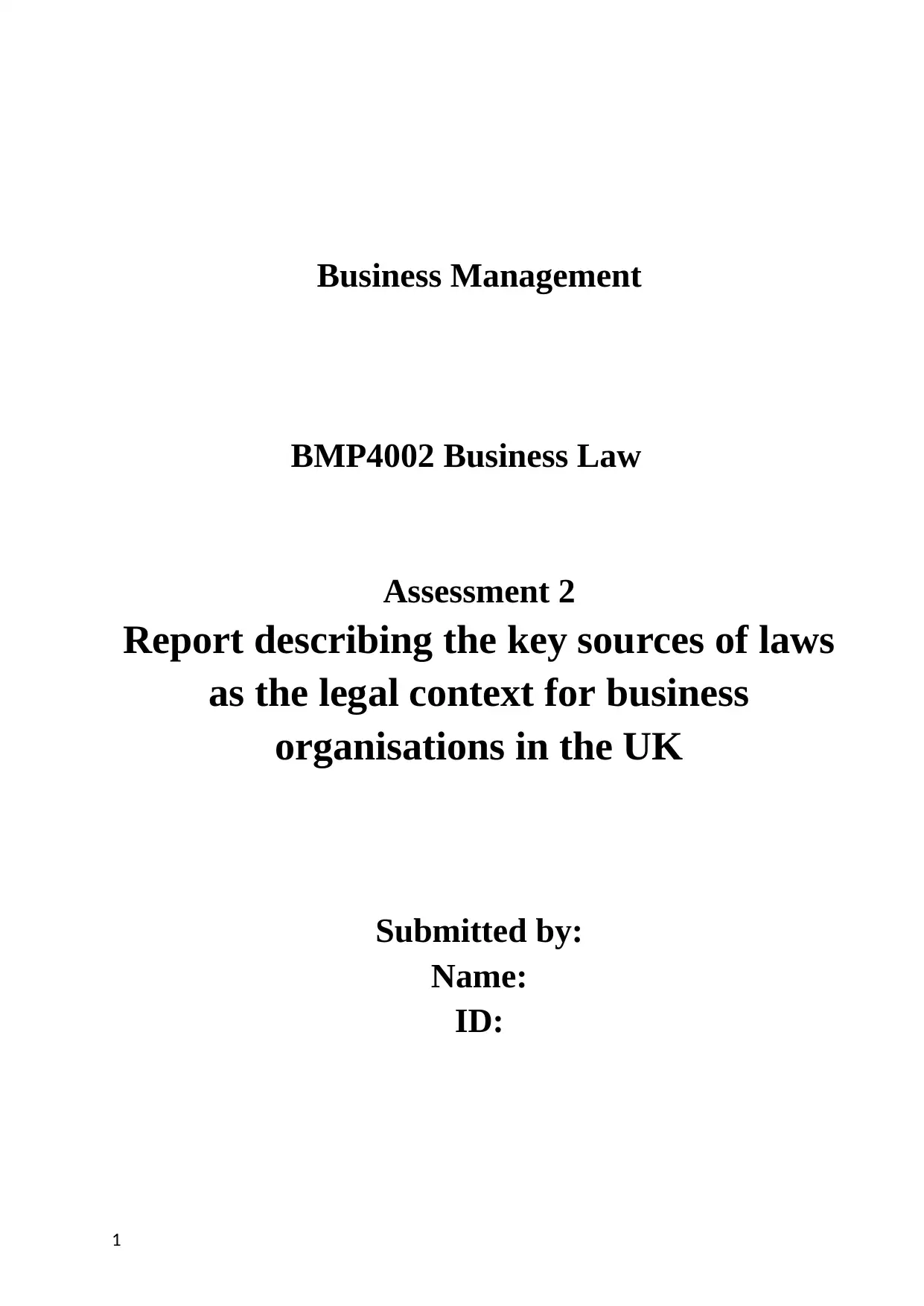
Business Management
BMP4002 Business Law
Assessment 2
Report describing the key sources of laws
as the legal context for business
organisations in the UK
Submitted by:
Name:
ID:
1
BMP4002 Business Law
Assessment 2
Report describing the key sources of laws
as the legal context for business
organisations in the UK
Submitted by:
Name:
ID:
1
Paraphrase This Document
Need a fresh take? Get an instant paraphrase of this document with our AI Paraphraser

Contents
Introduction…………………………………………………………p
Businesses & Organizations in the UK…………………………..p
The legal business structure of UK companies………………….p
Recommendations for IOM Solutions……………………………..p
Conclusion…………………………………………………………...p
2
Introduction…………………………………………………………p
Businesses & Organizations in the UK…………………………..p
The legal business structure of UK companies………………….p
Recommendations for IOM Solutions……………………………..p
Conclusion…………………………………………………………...p
2
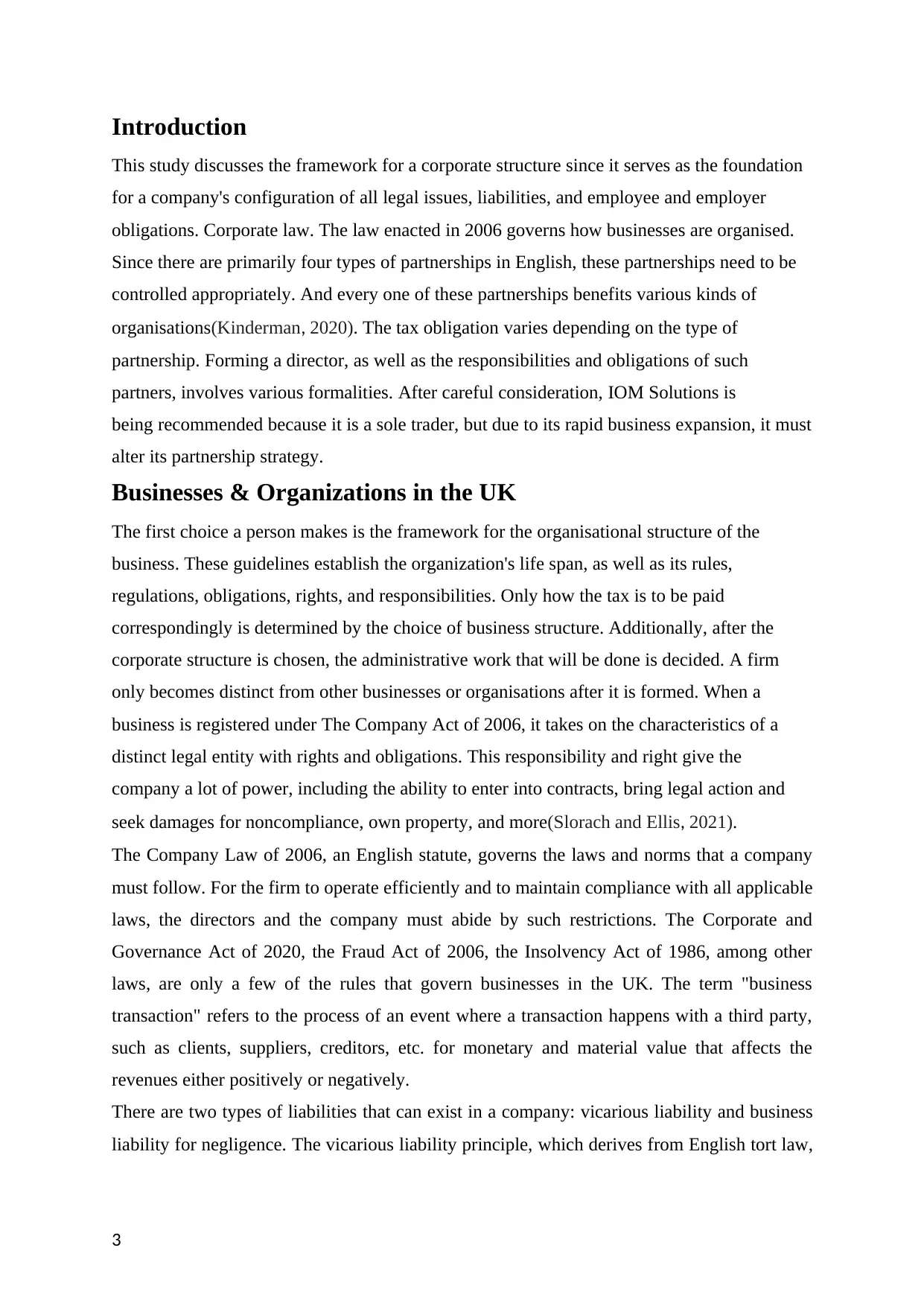
Introduction
This study discusses the framework for a corporate structure since it serves as the foundation
for a company's configuration of all legal issues, liabilities, and employee and employer
obligations. Corporate law. The law enacted in 2006 governs how businesses are organised.
Since there are primarily four types of partnerships in English, these partnerships need to be
controlled appropriately. And every one of these partnerships benefits various kinds of
organisations(Kinderman, 2020). The tax obligation varies depending on the type of
partnership. Forming a director, as well as the responsibilities and obligations of such
partners, involves various formalities. After careful consideration, IOM Solutions is
being recommended because it is a sole trader, but due to its rapid business expansion, it must
alter its partnership strategy.
Businesses & Organizations in the UK
The first choice a person makes is the framework for the organisational structure of the
business. These guidelines establish the organization's life span, as well as its rules,
regulations, obligations, rights, and responsibilities. Only how the tax is to be paid
correspondingly is determined by the choice of business structure. Additionally, after the
corporate structure is chosen, the administrative work that will be done is decided. A firm
only becomes distinct from other businesses or organisations after it is formed. When a
business is registered under The Company Act of 2006, it takes on the characteristics of a
distinct legal entity with rights and obligations. This responsibility and right give the
company a lot of power, including the ability to enter into contracts, bring legal action and
seek damages for noncompliance, own property, and more(Slorach and Ellis, 2021).
The Company Law of 2006, an English statute, governs the laws and norms that a company
must follow. For the firm to operate efficiently and to maintain compliance with all applicable
laws, the directors and the company must abide by such restrictions. The Corporate and
Governance Act of 2020, the Fraud Act of 2006, the Insolvency Act of 1986, among other
laws, are only a few of the rules that govern businesses in the UK. The term "business
transaction" refers to the process of an event where a transaction happens with a third party,
such as clients, suppliers, creditors, etc. for monetary and material value that affects the
revenues either positively or negatively.
There are two types of liabilities that can exist in a company: vicarious liability and business
liability for negligence. The vicarious liability principle, which derives from English tort law,
3
This study discusses the framework for a corporate structure since it serves as the foundation
for a company's configuration of all legal issues, liabilities, and employee and employer
obligations. Corporate law. The law enacted in 2006 governs how businesses are organised.
Since there are primarily four types of partnerships in English, these partnerships need to be
controlled appropriately. And every one of these partnerships benefits various kinds of
organisations(Kinderman, 2020). The tax obligation varies depending on the type of
partnership. Forming a director, as well as the responsibilities and obligations of such
partners, involves various formalities. After careful consideration, IOM Solutions is
being recommended because it is a sole trader, but due to its rapid business expansion, it must
alter its partnership strategy.
Businesses & Organizations in the UK
The first choice a person makes is the framework for the organisational structure of the
business. These guidelines establish the organization's life span, as well as its rules,
regulations, obligations, rights, and responsibilities. Only how the tax is to be paid
correspondingly is determined by the choice of business structure. Additionally, after the
corporate structure is chosen, the administrative work that will be done is decided. A firm
only becomes distinct from other businesses or organisations after it is formed. When a
business is registered under The Company Act of 2006, it takes on the characteristics of a
distinct legal entity with rights and obligations. This responsibility and right give the
company a lot of power, including the ability to enter into contracts, bring legal action and
seek damages for noncompliance, own property, and more(Slorach and Ellis, 2021).
The Company Law of 2006, an English statute, governs the laws and norms that a company
must follow. For the firm to operate efficiently and to maintain compliance with all applicable
laws, the directors and the company must abide by such restrictions. The Corporate and
Governance Act of 2020, the Fraud Act of 2006, the Insolvency Act of 1986, among other
laws, are only a few of the rules that govern businesses in the UK. The term "business
transaction" refers to the process of an event where a transaction happens with a third party,
such as clients, suppliers, creditors, etc. for monetary and material value that affects the
revenues either positively or negatively.
There are two types of liabilities that can exist in a company: vicarious liability and business
liability for negligence. The vicarious liability principle, which derives from English tort law,
3
⊘ This is a preview!⊘
Do you want full access?
Subscribe today to unlock all pages.

Trusted by 1+ million students worldwide
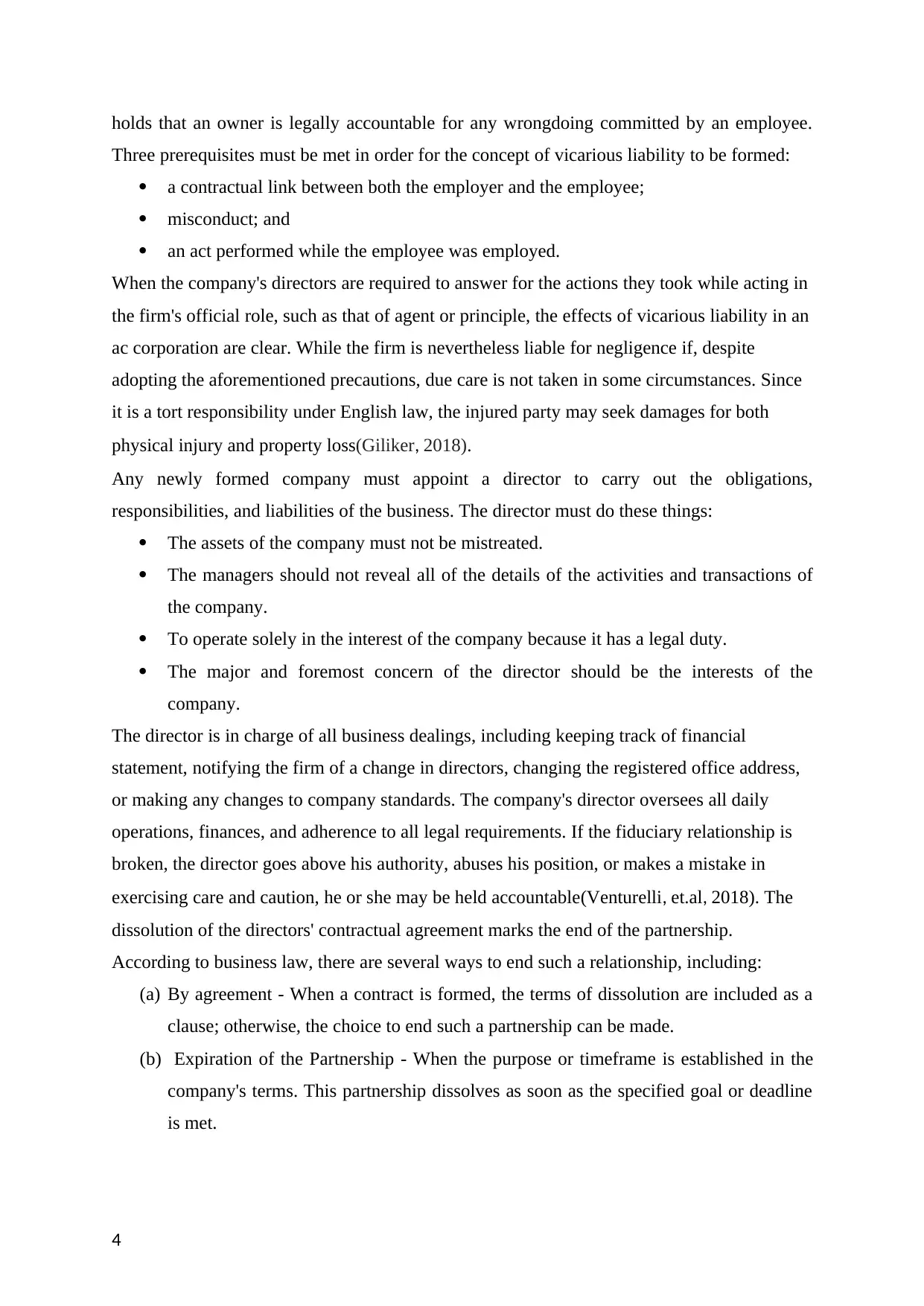
holds that an owner is legally accountable for any wrongdoing committed by an employee.
Three prerequisites must be met in order for the concept of vicarious liability to be formed:
a contractual link between both the employer and the employee;
misconduct; and
an act performed while the employee was employed.
When the company's directors are required to answer for the actions they took while acting in
the firm's official role, such as that of agent or principle, the effects of vicarious liability in an
ac corporation are clear. While the firm is nevertheless liable for negligence if, despite
adopting the aforementioned precautions, due care is not taken in some circumstances. Since
it is a tort responsibility under English law, the injured party may seek damages for both
physical injury and property loss(Giliker, 2018).
Any newly formed company must appoint a director to carry out the obligations,
responsibilities, and liabilities of the business. The director must do these things:
The assets of the company must not be mistreated.
The managers should not reveal all of the details of the activities and transactions of
the company.
To operate solely in the interest of the company because it has a legal duty.
The major and foremost concern of the director should be the interests of the
company.
The director is in charge of all business dealings, including keeping track of financial
statement, notifying the firm of a change in directors, changing the registered office address,
or making any changes to company standards. The company's director oversees all daily
operations, finances, and adherence to all legal requirements. If the fiduciary relationship is
broken, the director goes above his authority, abuses his position, or makes a mistake in
exercising care and caution, he or she may be held accountable(Venturelli, et.al, 2018). The
dissolution of the directors' contractual agreement marks the end of the partnership.
According to business law, there are several ways to end such a relationship, including:
(a) By agreement - When a contract is formed, the terms of dissolution are included as a
clause; otherwise, the choice to end such a partnership can be made.
(b) Expiration of the Partnership - When the purpose or timeframe is established in the
company's terms. This partnership dissolves as soon as the specified goal or deadline
is met.
4
Three prerequisites must be met in order for the concept of vicarious liability to be formed:
a contractual link between both the employer and the employee;
misconduct; and
an act performed while the employee was employed.
When the company's directors are required to answer for the actions they took while acting in
the firm's official role, such as that of agent or principle, the effects of vicarious liability in an
ac corporation are clear. While the firm is nevertheless liable for negligence if, despite
adopting the aforementioned precautions, due care is not taken in some circumstances. Since
it is a tort responsibility under English law, the injured party may seek damages for both
physical injury and property loss(Giliker, 2018).
Any newly formed company must appoint a director to carry out the obligations,
responsibilities, and liabilities of the business. The director must do these things:
The assets of the company must not be mistreated.
The managers should not reveal all of the details of the activities and transactions of
the company.
To operate solely in the interest of the company because it has a legal duty.
The major and foremost concern of the director should be the interests of the
company.
The director is in charge of all business dealings, including keeping track of financial
statement, notifying the firm of a change in directors, changing the registered office address,
or making any changes to company standards. The company's director oversees all daily
operations, finances, and adherence to all legal requirements. If the fiduciary relationship is
broken, the director goes above his authority, abuses his position, or makes a mistake in
exercising care and caution, he or she may be held accountable(Venturelli, et.al, 2018). The
dissolution of the directors' contractual agreement marks the end of the partnership.
According to business law, there are several ways to end such a relationship, including:
(a) By agreement - When a contract is formed, the terms of dissolution are included as a
clause; otherwise, the choice to end such a partnership can be made.
(b) Expiration of the Partnership - When the purpose or timeframe is established in the
company's terms. This partnership dissolves as soon as the specified goal or deadline
is met.
4
Paraphrase This Document
Need a fresh take? Get an instant paraphrase of this document with our AI Paraphraser
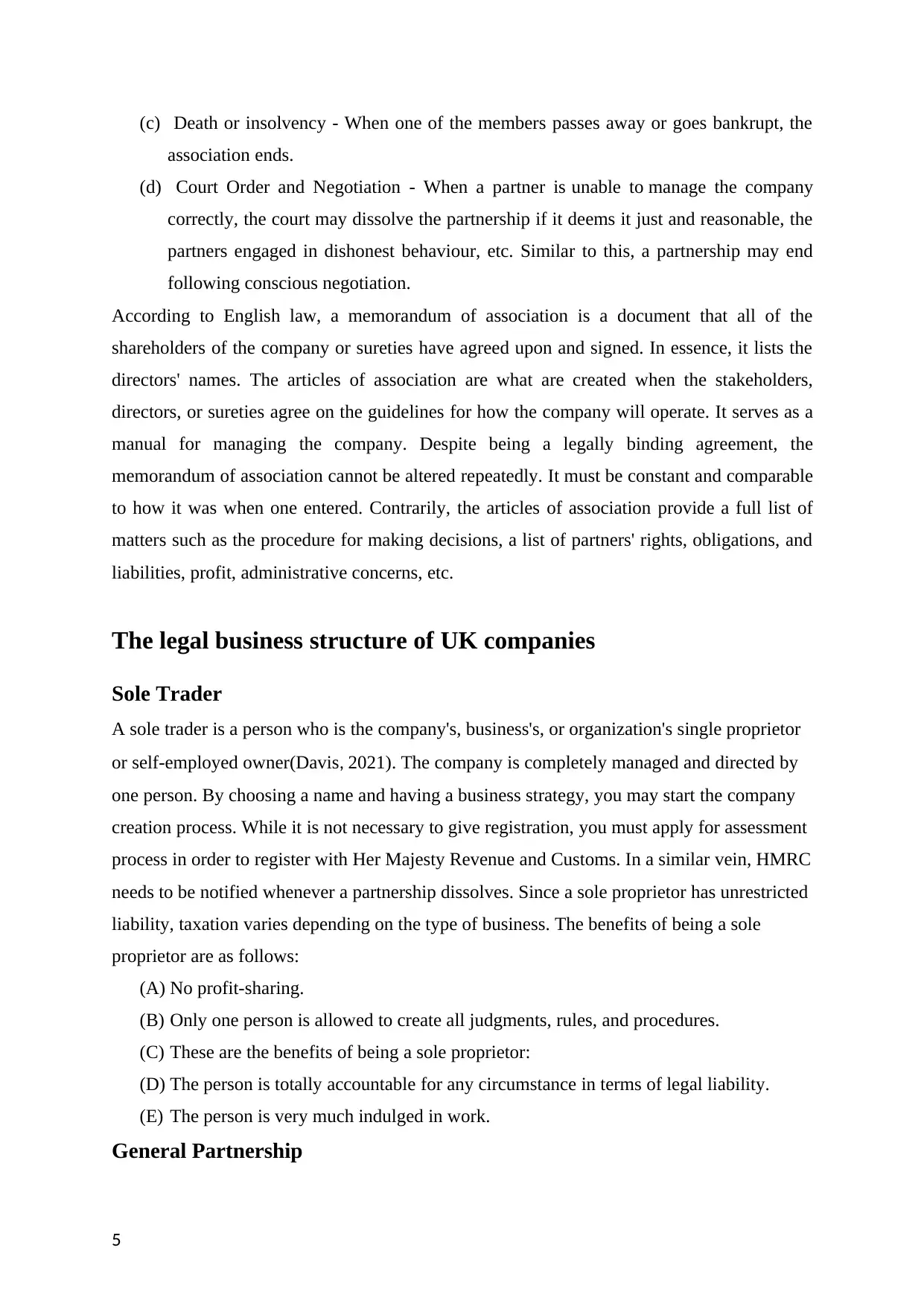
(c) Death or insolvency - When one of the members passes away or goes bankrupt, the
association ends.
(d) Court Order and Negotiation - When a partner is unable to manage the company
correctly, the court may dissolve the partnership if it deems it just and reasonable, the
partners engaged in dishonest behaviour, etc. Similar to this, a partnership may end
following conscious negotiation.
According to English law, a memorandum of association is a document that all of the
shareholders of the company or sureties have agreed upon and signed. In essence, it lists the
directors' names. The articles of association are what are created when the stakeholders,
directors, or sureties agree on the guidelines for how the company will operate. It serves as a
manual for managing the company. Despite being a legally binding agreement, the
memorandum of association cannot be altered repeatedly. It must be constant and comparable
to how it was when one entered. Contrarily, the articles of association provide a full list of
matters such as the procedure for making decisions, a list of partners' rights, obligations, and
liabilities, profit, administrative concerns, etc.
The legal business structure of UK companies
Sole Trader
A sole trader is a person who is the company's, business's, or organization's single proprietor
or self-employed owner(Davis, 2021). The company is completely managed and directed by
one person. By choosing a name and having a business strategy, you may start the company
creation process. While it is not necessary to give registration, you must apply for assessment
process in order to register with Her Majesty Revenue and Customs. In a similar vein, HMRC
needs to be notified whenever a partnership dissolves. Since a sole proprietor has unrestricted
liability, taxation varies depending on the type of business. The benefits of being a sole
proprietor are as follows:
(A) No profit-sharing.
(B) Only one person is allowed to create all judgments, rules, and procedures.
(C) These are the benefits of being a sole proprietor:
(D) The person is totally accountable for any circumstance in terms of legal liability.
(E) The person is very much indulged in work.
General Partnership
5
association ends.
(d) Court Order and Negotiation - When a partner is unable to manage the company
correctly, the court may dissolve the partnership if it deems it just and reasonable, the
partners engaged in dishonest behaviour, etc. Similar to this, a partnership may end
following conscious negotiation.
According to English law, a memorandum of association is a document that all of the
shareholders of the company or sureties have agreed upon and signed. In essence, it lists the
directors' names. The articles of association are what are created when the stakeholders,
directors, or sureties agree on the guidelines for how the company will operate. It serves as a
manual for managing the company. Despite being a legally binding agreement, the
memorandum of association cannot be altered repeatedly. It must be constant and comparable
to how it was when one entered. Contrarily, the articles of association provide a full list of
matters such as the procedure for making decisions, a list of partners' rights, obligations, and
liabilities, profit, administrative concerns, etc.
The legal business structure of UK companies
Sole Trader
A sole trader is a person who is the company's, business's, or organization's single proprietor
or self-employed owner(Davis, 2021). The company is completely managed and directed by
one person. By choosing a name and having a business strategy, you may start the company
creation process. While it is not necessary to give registration, you must apply for assessment
process in order to register with Her Majesty Revenue and Customs. In a similar vein, HMRC
needs to be notified whenever a partnership dissolves. Since a sole proprietor has unrestricted
liability, taxation varies depending on the type of business. The benefits of being a sole
proprietor are as follows:
(A) No profit-sharing.
(B) Only one person is allowed to create all judgments, rules, and procedures.
(C) These are the benefits of being a sole proprietor:
(D) The person is totally accountable for any circumstance in terms of legal liability.
(E) The person is very much indulged in work.
General Partnership
5
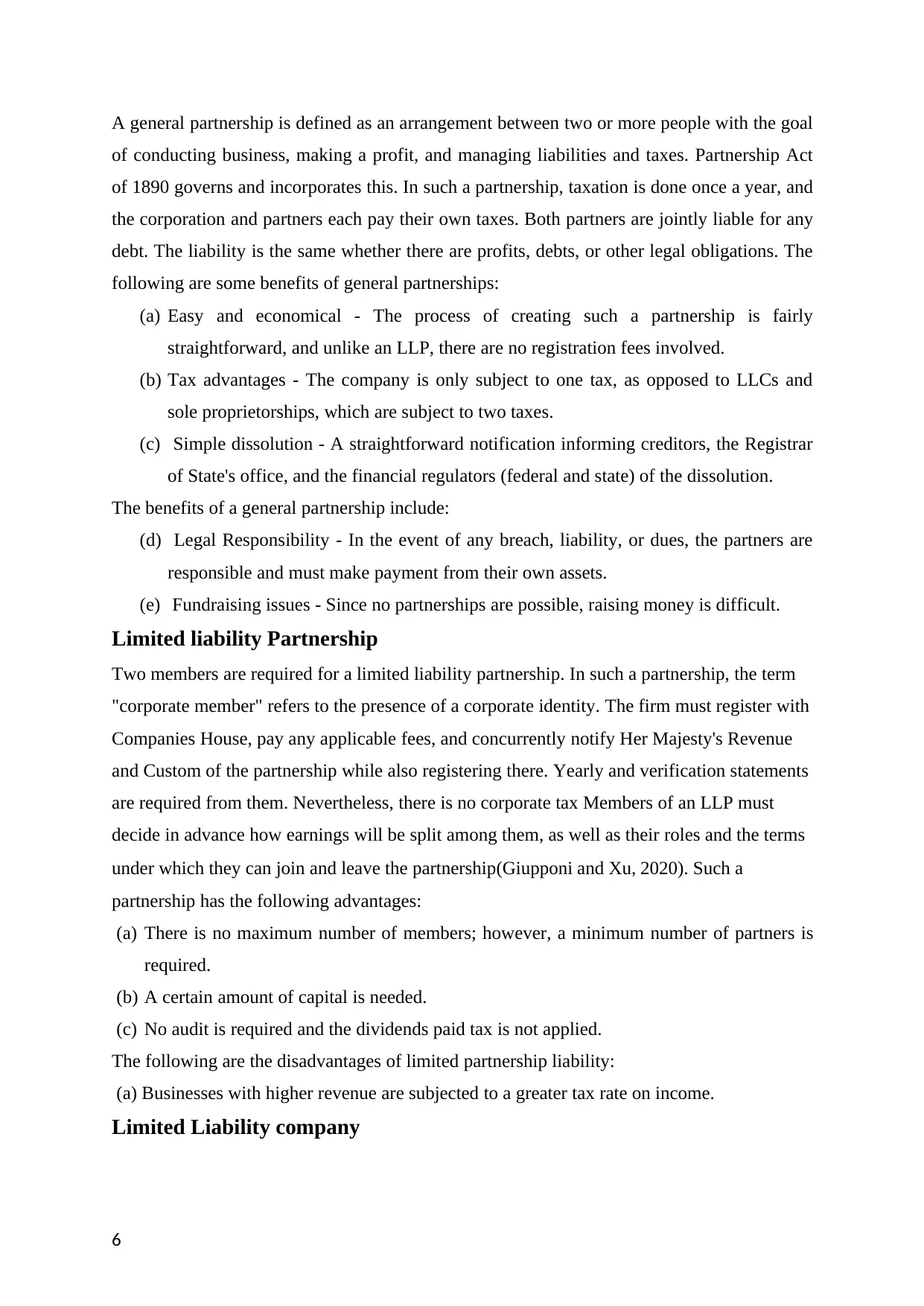
A general partnership is defined as an arrangement between two or more people with the goal
of conducting business, making a profit, and managing liabilities and taxes. Partnership Act
of 1890 governs and incorporates this. In such a partnership, taxation is done once a year, and
the corporation and partners each pay their own taxes. Both partners are jointly liable for any
debt. The liability is the same whether there are profits, debts, or other legal obligations. The
following are some benefits of general partnerships:
(a) Easy and economical - The process of creating such a partnership is fairly
straightforward, and unlike an LLP, there are no registration fees involved.
(b) Tax advantages - The company is only subject to one tax, as opposed to LLCs and
sole proprietorships, which are subject to two taxes.
(c) Simple dissolution - A straightforward notification informing creditors, the Registrar
of State's office, and the financial regulators (federal and state) of the dissolution.
The benefits of a general partnership include:
(d) Legal Responsibility - In the event of any breach, liability, or dues, the partners are
responsible and must make payment from their own assets.
(e) Fundraising issues - Since no partnerships are possible, raising money is difficult.
Limited liability Partnership
Two members are required for a limited liability partnership. In such a partnership, the term
"corporate member" refers to the presence of a corporate identity. The firm must register with
Companies House, pay any applicable fees, and concurrently notify Her Majesty's Revenue
and Custom of the partnership while also registering there. Yearly and verification statements
are required from them. Nevertheless, there is no corporate tax Members of an LLP must
decide in advance how earnings will be split among them, as well as their roles and the terms
under which they can join and leave the partnership(Giupponi and Xu, 2020). Such a
partnership has the following advantages:
(a) There is no maximum number of members; however, a minimum number of partners is
required.
(b) A certain amount of capital is needed.
(c) No audit is required and the dividends paid tax is not applied.
The following are the disadvantages of limited partnership liability:
(a) Businesses with higher revenue are subjected to a greater tax rate on income.
Limited Liability company
6
of conducting business, making a profit, and managing liabilities and taxes. Partnership Act
of 1890 governs and incorporates this. In such a partnership, taxation is done once a year, and
the corporation and partners each pay their own taxes. Both partners are jointly liable for any
debt. The liability is the same whether there are profits, debts, or other legal obligations. The
following are some benefits of general partnerships:
(a) Easy and economical - The process of creating such a partnership is fairly
straightforward, and unlike an LLP, there are no registration fees involved.
(b) Tax advantages - The company is only subject to one tax, as opposed to LLCs and
sole proprietorships, which are subject to two taxes.
(c) Simple dissolution - A straightforward notification informing creditors, the Registrar
of State's office, and the financial regulators (federal and state) of the dissolution.
The benefits of a general partnership include:
(d) Legal Responsibility - In the event of any breach, liability, or dues, the partners are
responsible and must make payment from their own assets.
(e) Fundraising issues - Since no partnerships are possible, raising money is difficult.
Limited liability Partnership
Two members are required for a limited liability partnership. In such a partnership, the term
"corporate member" refers to the presence of a corporate identity. The firm must register with
Companies House, pay any applicable fees, and concurrently notify Her Majesty's Revenue
and Custom of the partnership while also registering there. Yearly and verification statements
are required from them. Nevertheless, there is no corporate tax Members of an LLP must
decide in advance how earnings will be split among them, as well as their roles and the terms
under which they can join and leave the partnership(Giupponi and Xu, 2020). Such a
partnership has the following advantages:
(a) There is no maximum number of members; however, a minimum number of partners is
required.
(b) A certain amount of capital is needed.
(c) No audit is required and the dividends paid tax is not applied.
The following are the disadvantages of limited partnership liability:
(a) Businesses with higher revenue are subjected to a greater tax rate on income.
Limited Liability company
6
⊘ This is a preview!⊘
Do you want full access?
Subscribe today to unlock all pages.

Trusted by 1+ million students worldwide
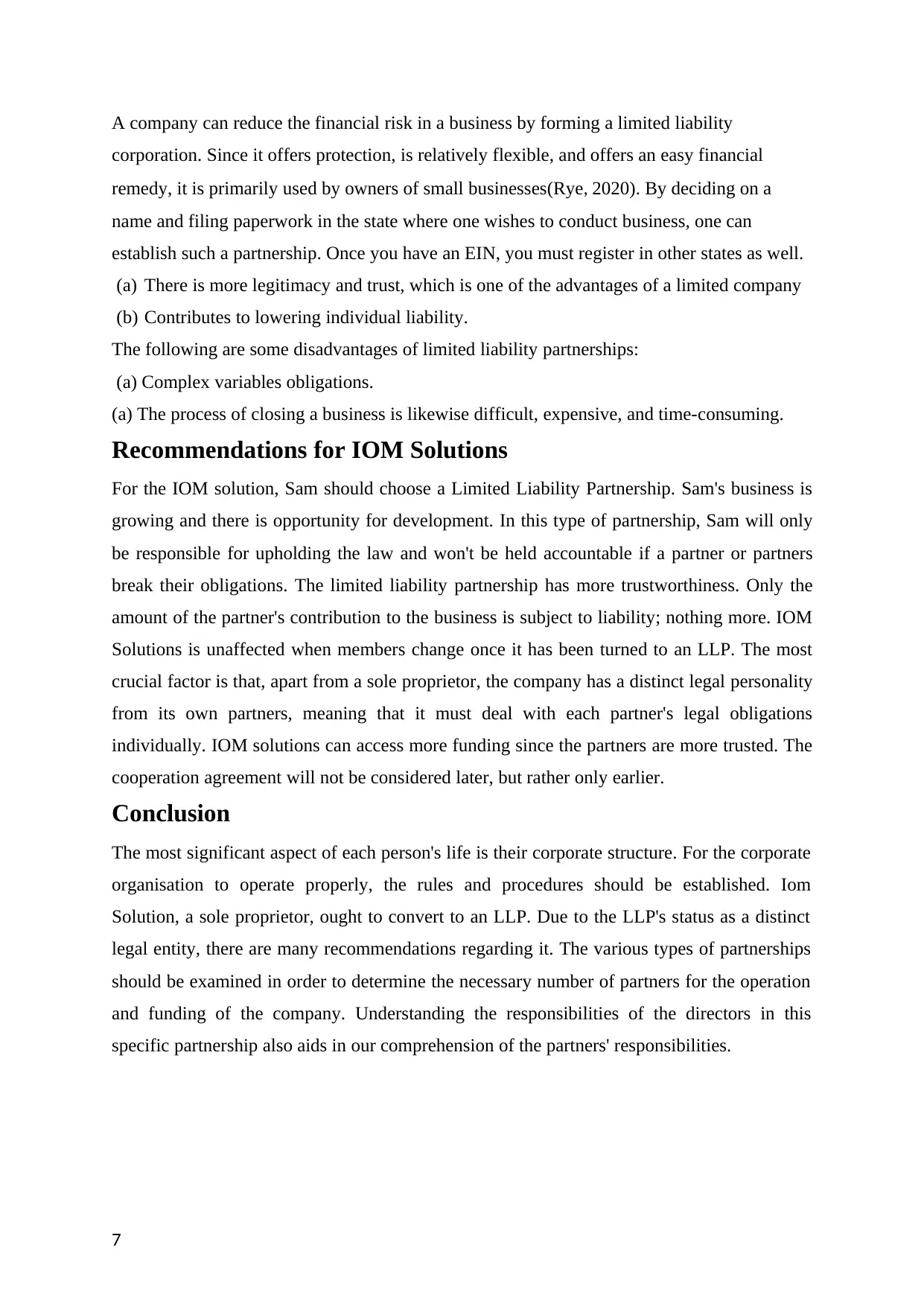
A company can reduce the financial risk in a business by forming a limited liability
corporation. Since it offers protection, is relatively flexible, and offers an easy financial
remedy, it is primarily used by owners of small businesses(Rye, 2020). By deciding on a
name and filing paperwork in the state where one wishes to conduct business, one can
establish such a partnership. Once you have an EIN, you must register in other states as well.
(a) There is more legitimacy and trust, which is one of the advantages of a limited company
(b) Contributes to lowering individual liability.
The following are some disadvantages of limited liability partnerships:
(a) Complex variables obligations.
(a) The process of closing a business is likewise difficult, expensive, and time-consuming.
Recommendations for IOM Solutions
For the IOM solution, Sam should choose a Limited Liability Partnership. Sam's business is
growing and there is opportunity for development. In this type of partnership, Sam will only
be responsible for upholding the law and won't be held accountable if a partner or partners
break their obligations. The limited liability partnership has more trustworthiness. Only the
amount of the partner's contribution to the business is subject to liability; nothing more. IOM
Solutions is unaffected when members change once it has been turned to an LLP. The most
crucial factor is that, apart from a sole proprietor, the company has a distinct legal personality
from its own partners, meaning that it must deal with each partner's legal obligations
individually. IOM solutions can access more funding since the partners are more trusted. The
cooperation agreement will not be considered later, but rather only earlier.
Conclusion
The most significant aspect of each person's life is their corporate structure. For the corporate
organisation to operate properly, the rules and procedures should be established. Iom
Solution, a sole proprietor, ought to convert to an LLP. Due to the LLP's status as a distinct
legal entity, there are many recommendations regarding it. The various types of partnerships
should be examined in order to determine the necessary number of partners for the operation
and funding of the company. Understanding the responsibilities of the directors in this
specific partnership also aids in our comprehension of the partners' responsibilities.
7
corporation. Since it offers protection, is relatively flexible, and offers an easy financial
remedy, it is primarily used by owners of small businesses(Rye, 2020). By deciding on a
name and filing paperwork in the state where one wishes to conduct business, one can
establish such a partnership. Once you have an EIN, you must register in other states as well.
(a) There is more legitimacy and trust, which is one of the advantages of a limited company
(b) Contributes to lowering individual liability.
The following are some disadvantages of limited liability partnerships:
(a) Complex variables obligations.
(a) The process of closing a business is likewise difficult, expensive, and time-consuming.
Recommendations for IOM Solutions
For the IOM solution, Sam should choose a Limited Liability Partnership. Sam's business is
growing and there is opportunity for development. In this type of partnership, Sam will only
be responsible for upholding the law and won't be held accountable if a partner or partners
break their obligations. The limited liability partnership has more trustworthiness. Only the
amount of the partner's contribution to the business is subject to liability; nothing more. IOM
Solutions is unaffected when members change once it has been turned to an LLP. The most
crucial factor is that, apart from a sole proprietor, the company has a distinct legal personality
from its own partners, meaning that it must deal with each partner's legal obligations
individually. IOM solutions can access more funding since the partners are more trusted. The
cooperation agreement will not be considered later, but rather only earlier.
Conclusion
The most significant aspect of each person's life is their corporate structure. For the corporate
organisation to operate properly, the rules and procedures should be established. Iom
Solution, a sole proprietor, ought to convert to an LLP. Due to the LLP's status as a distinct
legal entity, there are many recommendations regarding it. The various types of partnerships
should be examined in order to determine the necessary number of partners for the operation
and funding of the company. Understanding the responsibilities of the directors in this
specific partnership also aids in our comprehension of the partners' responsibilities.
7
Paraphrase This Document
Need a fresh take? Get an instant paraphrase of this document with our AI Paraphraser
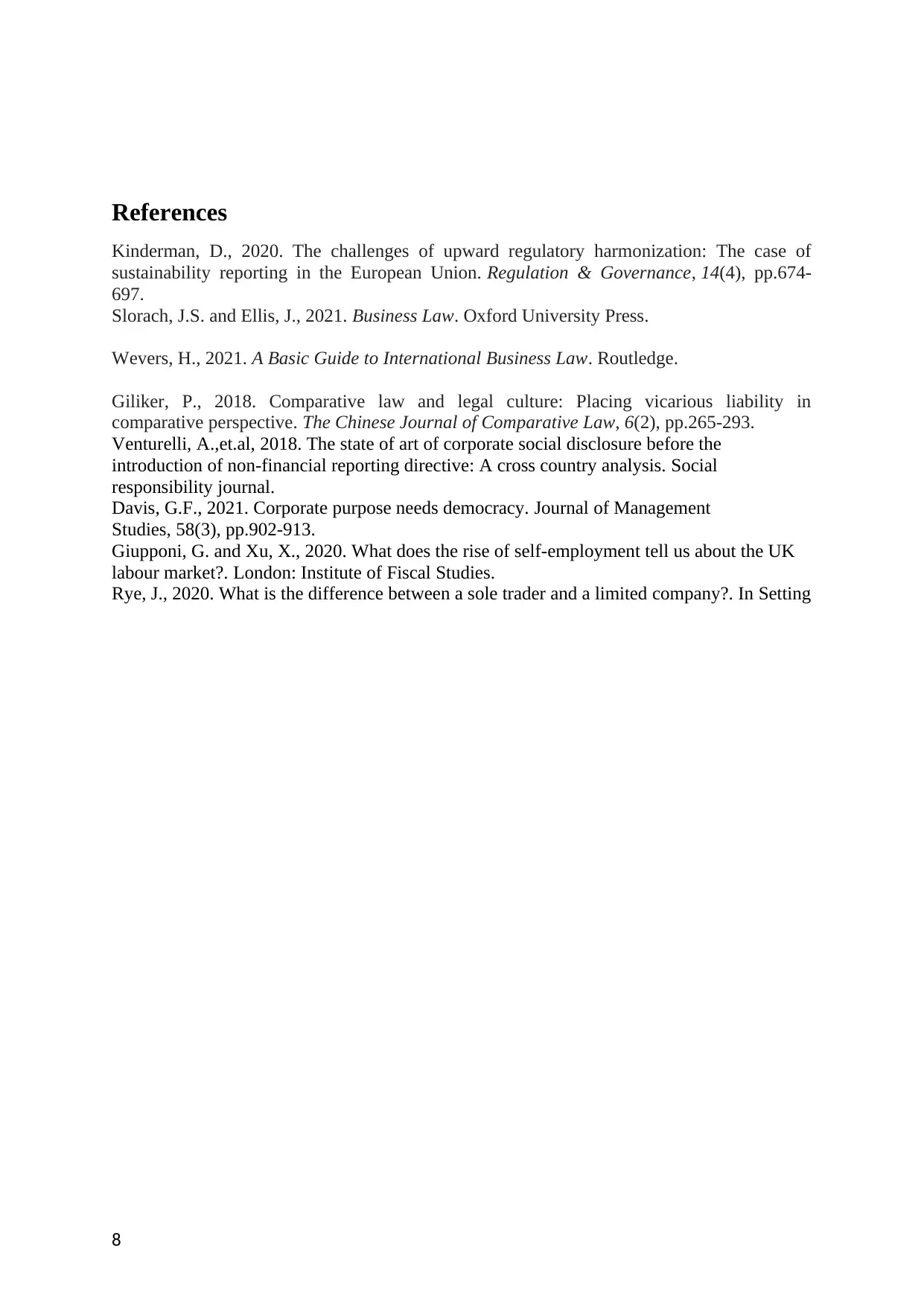
References
Kinderman, D., 2020. The challenges of upward regulatory harmonization: The case of
sustainability reporting in the European Union. Regulation & Governance, 14(4), pp.674-
697.
Slorach, J.S. and Ellis, J., 2021. Business Law. Oxford University Press.
Wevers, H., 2021. A Basic Guide to International Business Law. Routledge.
Giliker, P., 2018. Comparative law and legal culture: Placing vicarious liability in
comparative perspective. The Chinese Journal of Comparative Law, 6(2), pp.265-293.
Venturelli, A.,et.al, 2018. The state of art of corporate social disclosure before the
introduction of non-financial reporting directive: A cross country analysis. Social
responsibility journal.
Davis, G.F., 2021. Corporate purpose needs democracy. Journal of Management
Studies, 58(3), pp.902-913.
Giupponi, G. and Xu, X., 2020. What does the rise of self-employment tell us about the UK
labour market?. London: Institute of Fiscal Studies.
Rye, J., 2020. What is the difference between a sole trader and a limited company?. In Setting
8
Kinderman, D., 2020. The challenges of upward regulatory harmonization: The case of
sustainability reporting in the European Union. Regulation & Governance, 14(4), pp.674-
697.
Slorach, J.S. and Ellis, J., 2021. Business Law. Oxford University Press.
Wevers, H., 2021. A Basic Guide to International Business Law. Routledge.
Giliker, P., 2018. Comparative law and legal culture: Placing vicarious liability in
comparative perspective. The Chinese Journal of Comparative Law, 6(2), pp.265-293.
Venturelli, A.,et.al, 2018. The state of art of corporate social disclosure before the
introduction of non-financial reporting directive: A cross country analysis. Social
responsibility journal.
Davis, G.F., 2021. Corporate purpose needs democracy. Journal of Management
Studies, 58(3), pp.902-913.
Giupponi, G. and Xu, X., 2020. What does the rise of self-employment tell us about the UK
labour market?. London: Institute of Fiscal Studies.
Rye, J., 2020. What is the difference between a sole trader and a limited company?. In Setting
8
1 out of 8
Related Documents
Your All-in-One AI-Powered Toolkit for Academic Success.
+13062052269
info@desklib.com
Available 24*7 on WhatsApp / Email
![[object Object]](/_next/static/media/star-bottom.7253800d.svg)
Unlock your academic potential
Copyright © 2020–2025 A2Z Services. All Rights Reserved. Developed and managed by ZUCOL.


